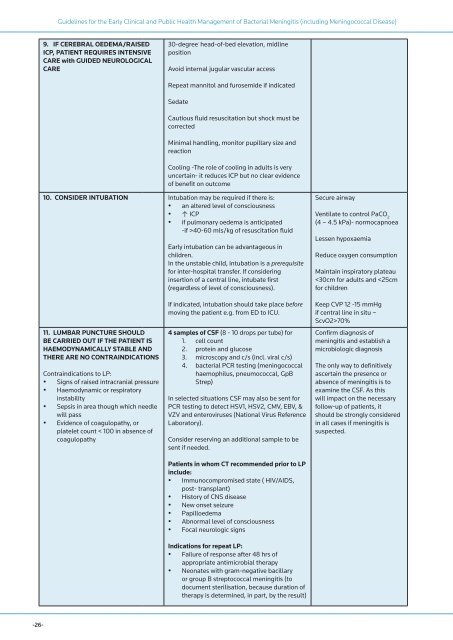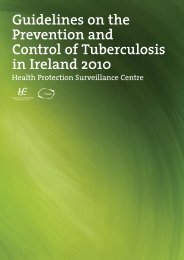Guidelines for the Early Clinical and Public Health Management of ...
Guidelines for the Early Clinical and Public Health Management of ...
Guidelines for the Early Clinical and Public Health Management of ...
You also want an ePaper? Increase the reach of your titles
YUMPU automatically turns print PDFs into web optimized ePapers that Google loves.
<strong>Guidelines</strong> <strong>for</strong> <strong>the</strong> <strong>Early</strong> <strong>Clinical</strong> <strong>and</strong> <strong>Public</strong> <strong>Health</strong> <strong>Management</strong> <strong>of</strong> Bacterial Meningitis (including Meningococcal Disease)<br />
9. IF CEREBRAL OEDEMA/RAISED<br />
ICP, PATIENT REQUIRES INTENSIVE<br />
CARE with GUIDED NEUROLOGICAL<br />
CARE<br />
30-degree - head-<strong>of</strong>-bed elevation, midline<br />
position<br />
Avoid internal jugular vascular access<br />
Repeat mannitol <strong>and</strong> furosemide if indicated<br />
Sedate<br />
Cautious fluid resuscitation but shock must be<br />
corrected<br />
Minimal h<strong>and</strong>ling, monitor pupillary size <strong>and</strong><br />
reaction<br />
Cooling -The role <strong>of</strong> cooling in adults is very<br />
uncertain- it reduces ICP but no clear evidence<br />
<strong>of</strong> benefit on outcome<br />
10. CONSIDER INTUBATION Intubation may be required if <strong>the</strong>re is:<br />
• an altered level <strong>of</strong> consciousness<br />
• ↑ ICP<br />
• if pulmonary oedema is anticipated<br />
-if >40-60 mls/kg <strong>of</strong> resuscitation fluid<br />
<strong>Early</strong> intubation can be advantageous in<br />
children.<br />
In <strong>the</strong> unstable child, intubation is a prerequisite<br />
<strong>for</strong> inter-hospital transfer. If considering<br />
insertion <strong>of</strong> a central line, intubate first<br />
(regardless <strong>of</strong> level <strong>of</strong> consciousness).<br />
Secure airway<br />
Ventilate to control PaCO 2<br />
(4 – 4.5 kPa)- normocapnoea<br />
Lessen hypoxaemia<br />
Reduce oxygen consumption<br />
Maintain inspiratory plateau<br />

















